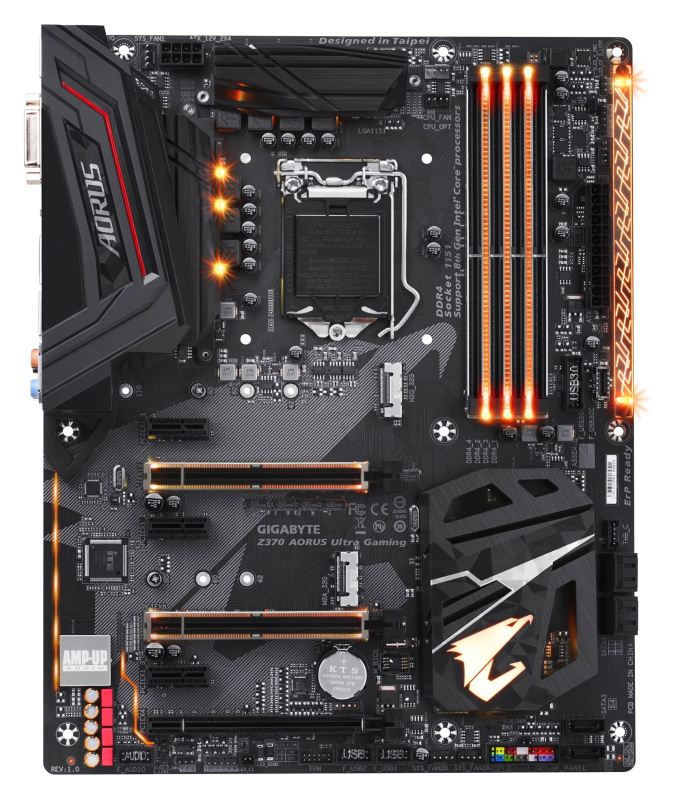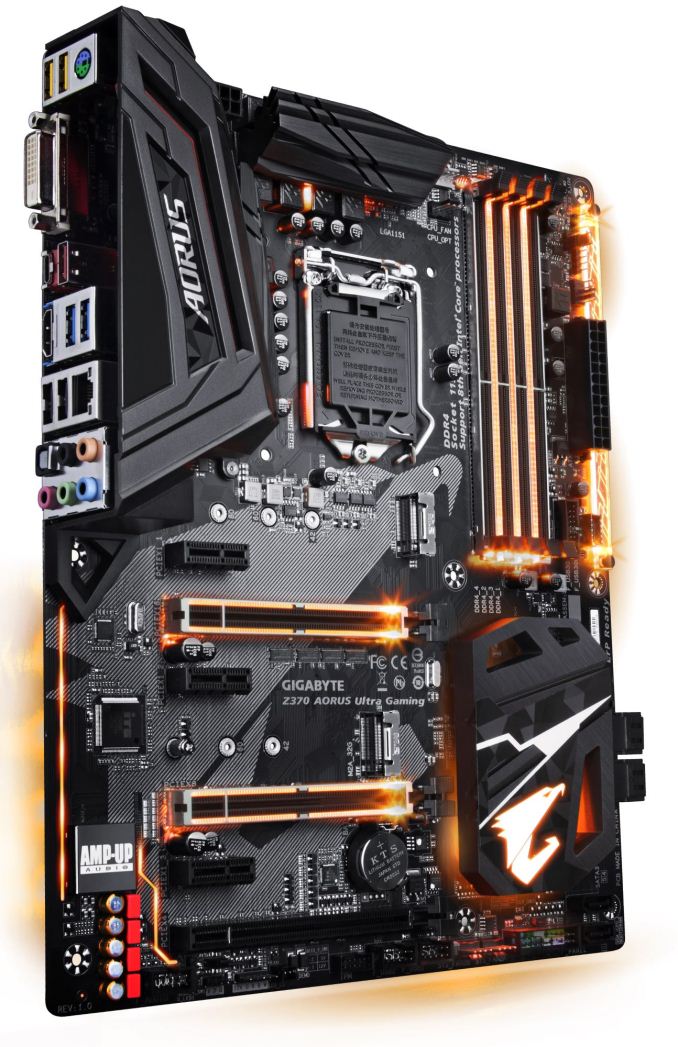Analyzing Z370 for Intel's 8th Generation Coffee Lake: A Quick Look at 50+ Motherboards
by Ian Cutress, Anton Shilov, Joe Shields & Gavin Bonshor on October 20, 2017 2:00 PM ESTGIGABYTE Z370 Ultra Gaming
The next board we will take a high-level look at is the Z370 Ultra Gaming. The Ultra Gaming appears to fall somewhere in the middle of the AORUS lineup offering a mix of features.
Appearance wise, the PCB is black with the AORUS bird stenciled in from the Audio area going through the PCIe slots and ending around the bottom of the CPU socket. RGB LEDs are used in multiple locations including around the VRM area, between the memory slots, and a strip on the right side going from mid-board to the top. The separation line between the audio section and the rest of the motherboard has LEDs, as well as the two fortified PCIe slots and the PCH heatsink. Compared to the Gaming 5 and Gaming 7, it loses LEDs on the VRM heatsink and back panel shroud. On the board there are also two 5-pin headers for external RGBW LED strips, both supporting true white, and two more regular RGB headers, all of which are controlled by the RGB Fusion Software. The Ultra Gaming board uses a different VRM with what looks like 7 phases as opposed to the 10 phase the Gaming 5/7 runs with. We can see it is using International Rectifier chokes, likely to be the same 40A/50A models we have seen on other GIGABYTE boards. Two separate heatsinks cover each set of VRMs to help keep them cool.
The board uses four reinforced memory slots supporting dual-channel DDR4 with capacity up to 64GB, and speeds supported up to DDR-4000. There are two steel protected full-length PCIe 3.0 slots, operating at x16 and x8 respectively, using lanes sourced from the CPU. There is another unprotected full-length PCIe 3.0 slot at the bottom of the board; it is limited to x4 bandwidth from the chipset and used for add-on cards. Additionally, there are three PCIe 3.0 x1 slots to round out PCIe capabilities. The board supports 2-way SLI via the reinforced slots, and 3-Way Crossfire using all the full-length PCIe slots.
For storage, the Z370 AORUS Ultra Gaming gives users a total of six SATA ports and two M.2 PCIe 3.0 x4 slots. The first M.2 connector can hold up to 110mm drives and is located above all the PCIe slots. The second slot, found between the second PCIe x1 slot and second full-length slot, supports up to 80 mm drives. There are several fan headers scattered around the board, five according to my cursory glance, located around the socket and to the right, as well across the bottom of the board. Audio duties are handled by the latest Realtek ALC1220 codec while networking is taken care of by a single Intel I219-V NIC. The Ultra Gaming also includes a Thunderbolt 3 header located just above the SATA ports for a TB3 add-in card.
The board supports USB 3.1 (10 Gbps) with a Type-A and Type-C headers found on the rear I/O only. There is a USB 3.1 (5 Gbps) header for the chassis, although we find four ports on the rear panel. There is a USB 3.1 (10 Gbps) style header on the board as well, although from what we can determine, this has only 3.1 (5 Gbps) bandwidth.
Boards further up the stack like the Gaming 5 offer an additional M.2 slot, or in the case of the Gaming 7, the additional M.2 slot and better audio hardware. The Ultra Gaming does not have onboard power and reset buttons nor a debug LED - it would appear these are options commonly targeted towards enthusiasts. In that respect, the stripped down Ultra Gaming is focusing on users who set the system up, then leave it until it is time to upgrade.













83 Comments
View All Comments
sor - Friday, October 20, 2017 - link
Damn. At least key it differently and call it LGA1151v2 or something.The changes are so minimal it really does seem like planned obsolescence. Does it really need more power pins to support new chips with the same power envelopes? Really? They couldn’t handle that on the CPU PCB?
KaarlisK - Saturday, October 21, 2017 - link
Actually it is ~1.5 times peak current with the same average power envelope, so yes, they need the change.If they had not brought the launch forward and just launched together with the cheap chipsets, there would be far less complaints.
sor - Saturday, October 21, 2017 - link
Where did you find information indicating current has increased 50%? I just spent about ten minutes trying to find a reference backing that up, perhaps something indicating the 8 series operates at a much lower voltage within same TDP, which would translate to higher current but they seem to operate in the same 1.2-1.3v range.You’re not just assuming they draw more current because they have two more cores, are you?
KaarlisK - Sunday, October 22, 2017 - link
Notice the difference between average and peak.And the information is in publicly available documents. I did not bother to look it up, but others have, for example: https://forum.beyond3d.com/threads/intel-coffee-la...
Crono - Saturday, October 21, 2017 - link
Nice roundup. That's a lot of motherboards to spec and summarize. I especially appreciate the handy chart at the end, it's a good, quick-and-dirty comparison tool.Landcross - Saturday, October 21, 2017 - link
You guys forgot 2 new Z370 boards from Supermicro :)https://motherboarddb.com/motherboards/?chipset=19...
Xpl1c1t - Sunday, October 22, 2017 - link
The mITX board looks incredible.+ Low ESR Tantalum capacitors! (first time seeing them on VRM duty on a mainboard)
+ HDMI 2.0
+ 2x M.2 Slots
+ USB 3.1 Type C
+ Optical SPDIF
- RGB.......
MadAd - Saturday, October 21, 2017 - link
Great write up but for me its just another depressing generation of oversized, overpriced ATX form factor offerings on which the vast majority of users wont even plug a second gpu into, with the smaller and more size appropriate FF represented as a minority afterthought.With all the progress of PCs since the 90s whod have thought that I could still use the same ATX case today while every single other component (from floppy drives to 2d Mattrox cards) have long gone to the recyclers. I find it so annoying how manufacturers have stuck on this prehistoric gargantuan case size with the other sizes being an afterthought. It feels like like stifled innovation while everything else is moving on.
rocky12345 - Saturday, October 21, 2017 - link
Great article and a lot of work put in to get it out for us to read thank you.My only issue is and it is nit your fault is why these companies feel the need to totally blanket the market with basically the same boards just a different model number and basically a few tiny changes and spray paint it a different color and use the word gaming and put something x or x1 or k,k3 etc etc. For crap sakes just release three models not 7-10 models of the same crap it is pretty much just greed I guess.
The whole market is like this now with anything computer related of and if it has the words GAMING or RGB in it's got to be good for sure. My fav is that gaming mouse pad next it will have RGB lighting in it...lol
CitizenZer0 - Wednesday, October 25, 2017 - link
Agreed